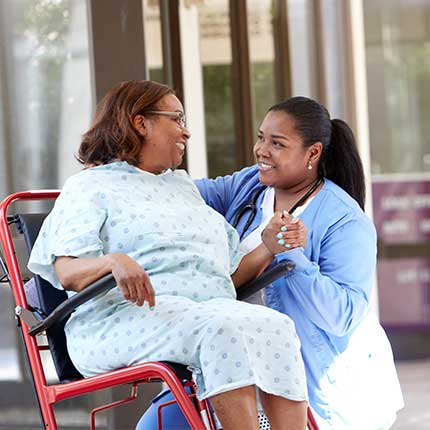Healthy Living: Orthopedics
Back Pain Causes and Treatments for Osteoporosis
Back pain causes and treatments tend to get more attention as we age. One example is osteoporosis that increases the chances of fractures in our vertebra – the small rectangular bones that make up our backs. About 25 percent of postmenopausal women will have vertebral compression fractures. Fortunately, a minimally invasive technique called kyphoplasty offers relief for many people who suffer pain or have spinal deformities because of vertebral compression fractures.
Back Pain Causes
When vertebra collapse or break, the spine shortens and bends forward. Pain may last for months while the bone continues to collapse. Once the pain goes away, it may indicate that the bone has healed in the collapsed position, creating a deformity in posture. People with vertebral compression fractures also are at greater risk for breathing problems, loss of appetite and difficulty with walking.
Vertebra Treatment
To correct the deformity and relieve pain, your doctor may recommend kyphoplasty. During the procedure, a small tube is placed into the broken vertebra through a tiny incision in your back. Then a device called a “balloon tamp” is inserted into the tube and inflated, which pushes the bone back to its normal height and shape.
Once the bone has assumed its normal shape, the space created by the balloon tamp is filled with bone cement. Throughout the procedure, the doctor watches X-rays for guidance. Kyphoplasty may be performed under local or general anesthetic while the patient lies on his or her stomach.
How to Know if Kyphoplasty Is a Solution
Kyphoplasty is most appropriate within eight weeks of a vertebral fracture. It is not recommended for younger, otherwise healthy people, or for patients whose spinal curvature is caused by conditions other than osteoporosis (such as scoliosis), who suffer from a herniated disk or severe arthritis. Kyphoplasy may be effective in treating bones that are weakened by cancer.
To find out if a patient is a candidate for kyphoplasty, the doctor will order a series of tests. Those may include X-rays, bone scans and magnetic resonance imaging (MRI).
Some patients who undergo kyphoplasty stay in the hospital overnight, although many go home the same day. The procedure usually provides pain relief and increased movement within 72 hours, and 60 to 100 percent of patients rate their treatment a success. It is important to avoid strenuous activity and lifting heavy objects for at least six weeks.
Usually kyphoplasty is safe and effective, but because it is a surgical procedure, it does carry risks. Those may include a chance of:
- Infection where the skin is penetrated.
- Cement leaking outside the vertebra (usually not serious unless it moves into a potentially dangerous location like the spinal canal).
- Bleeding, increased back pain, numbness or tingling.
- Allergic reaction to the contrast dye used to guide the doctor during the procedure.
For more information about treatments for your back pain, please talk with your doctor.


